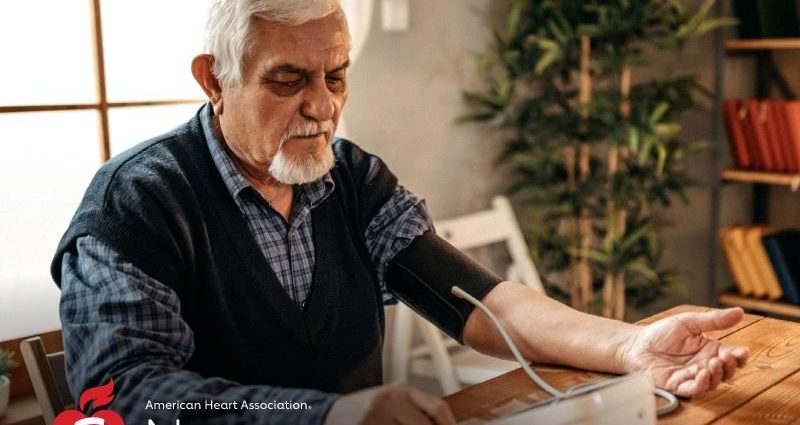FRIDAY, Sept. 16, 2022 (American Heart Association News) — Fewer than 30% of older adults who need more intensive treatment for high blood pressure actually get it, new research shows. And the problem may be worsening.
Nearly half of U.S. adults – about 116 million people – have high blood pressure, also known as hypertension. When not properly controlled, it can lead to serious health problems, including heart attack, stroke and kidney disease.
“We haven’t been doing well, despite robust evidence demonstrating the strong benefits of good blood pressure control in older adults,” said Dr. Nicholas Chiu, the study’s lead author and a clinical fellow at Beth Israel Deaconess Medical Center in Boston. “This is a major public health gap that needs to be tackled.”
Common in older adults, high blood pressure is a leading cause of preventable death and an under-recognized contributor to premature disability, according to the most recent hypertension care guidelines from the American College of Cardiology and American Heart Association.
Since 2017, high blood pressure has been defined by those organizations as a reading of 130 mmHg and higher for systolic blood pressure, the “top” number of a reading, or 80 and higher for the diastolic measurement, or “bottom” number. The old definition was 140/90 and higher.
For the new study, published Friday in the AHA journal Hypertension, researchers looked at a decade of national data from a sampling of adults 60 and older who visited their primary care provider and previously had been diagnosed with high blood pressure. The research team zeroed in on which patients underwent “appropriate antihypertensive intensification,” defined as adding an anti-hypertensive drug to their care for high blood pressure.
Based on office blood pressure measurements, treatment intensification was warranted in as many as 7,404 primary care visits captured in the data from 2008 to 2018, representative of up to 293 million visits nationally.
In determining who had high blood pressure, the researchers used three varied blood pressure targets – those published by ACC/AHA, the European Society of Cardiology, and the American College of Physicians/American Academy of Family Physicians (ACP/AAFP). The researchers also came up with their own all-inclusive measure that met all three guidelines.
Appropriate intensification of medicine over the study period never exceeded 27.5%. That was according to the most liberal measure, the all-inclusive yardstick, for patients who hadn’t previously been taking drugs for high blood pressure. By that same measure, just 15.3% of patients already on hypertension drugs had appropriate intensification.
Under all three of the published sets of targets, the percentage of patients receiving appropriate treatment intensification declined over the study period. Most dramatically, under ACP/AAFP targets, appropriate treatment intensification decreased from nearly 25% of patients in 2008-2009 to about 15% in 2015-2018.
Chiu called for professional societies to use more uniform blood pressure targets. “That could provide a bit more clarity” on what the best treatment strategy might be, he said.
While the study didn’t address the reasons behind the low numbers, senior author Dr. Kenneth Mukamal offered several theories, including doctors’ concerns that blood pressure-lowering drugs might cause older adults to fall, and patients’ reluctance to add more medications that might have more side effects.
He also said it can be difficult for primary care providers to treat high blood pressure aggressively in a typical 15-minute visit.
“We’re trying to control not just blood pressure, but cholesterol and diet and weight, and the documentation burdens have grown bigger as well. Speaking from my own experience, it’s harder than ever to be a primary care doctor,” said Mukamal, associate professor of medicine at Beth Israel Deaconess Medical Center.
He said future studies are needed to learn which strategies will motivate medical professionals to better treat high blood pressure among older adults. One strategy, Mukamal said, might involve “tweaking the medical record systems to automatically alert doctors to add a medication when a person’s blood pressure is above where we’d like it to be.”
Dr. Robert Brook, who was not involved in the new research, called it “an important study (that) highlights the remarkably high rates of treatment inertia in real-world clinical practices.”
“There’s a need for innovative strategies,” said Brook, a professor and director of cardiovascular disease prevention at Wayne State University in Detroit. “Growing evidence supports reducing or eliminating the mandatory role for physicians in the day-to-day management of uncomplicated hypertension. Algorithm-driven care delivered by pharmacists or nurses or trained community health workers has proven to improve blood pressure control in a variety of trials and vanguard programs.”
Patients also need to be more proactive, and know their blood pressure levels at home and in the clinic, Brook said. “They should work with their provider and encourage them to make the necessary treatment changes to achieve blood pressure control.”
American Heart Association News covers heart and brain health. Not all views expressed in this story reflect the official position of the American Heart Association. Copyright is owned or held by the American Heart Association, Inc., and all rights are reserved. If you have questions or comments about this story, please email editor@heart.org.
By Thor Christensen, American Heart Association News
Copyright © 2025 HealthDay. All rights reserved.

